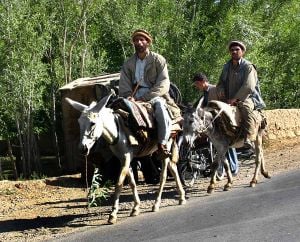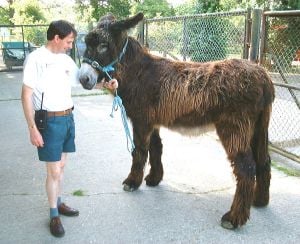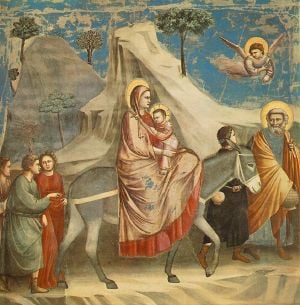Donkey
| Donkey Conservation status: Domesticated | ||||||||||||||
|---|---|---|---|---|---|---|---|---|---|---|---|---|---|---|
| Donkey | ||||||||||||||
| Scientific classification | ||||||||||||||
| ||||||||||||||
| Binomial name | ||||||||||||||
| Equus asinus Linnaeus, 1758 |
The donkey or ass, Equus asinus, is a member of the horse family, Equidae, of the order Perissodactyla, odd-toed ungulates (hoofed mammals). The word donkey refers to the domesticated E. asinus, while its wild ancestor, also E. asinus, is called the wild ass.
Donkeys were first domesticated around 4000 B.C.E. and have spread around the world in the company of humans. They continue to fill important roles in many places today and are increasing in numbers and popularity.
The wild ass
The wild ass is native to North Africa and the Arabian Peninsula.
Traits
Most wild donkeys are between 102 cm (10 hands) and 142 cm (14 hands) in length. Domestic donkeys stand under 91 cm ( 9 hands) to over 142 cm (over 14 hands) tall. The Andalucian-Cordobesan breed of southern Spain can reach up to 16 hands high. Donkeys are adapted to marginal desert lands, and have many traits that are unique to the species as a result. They need less food than horses. Overfed donkeys can suffer from a disease called Laminitis. Unlike horses, donkey fur is not waterproof, and so must have shelter especially when it rains. Wild donkeys live separated from each other, unlike tight wild horse herds. Donkeys have developed very loud voices, which can be heard for over three kilometres, to keep in contact with other donkeys of their herd over the wide spaces of the desert. Donkeys have larger ears than horses to hear the distant calls of fellow donkeys, and to help cool the donkey's blood. Donkeys' tough digestive system can break down inedible vegetation and extract moisture from food more efficiently. Donkeys can defend themselves with a powerful kick of their hind legs.
History
It is commonly believed that the ancestor of the modern donkey is the Nubian subspecies of African wild ass, a medium sized donkey with a grey and white coat, strips on back and legs and a tall, upright mane with a black tip. The African Wild Ass was domesticated around 4,000 B.C.E. The donkey became an important pack animal for people living in the Egyptian and Nubian regions as they can easily carry 20% to 30% of their own body weight and can also be used as a farming and dairy animal. By 1800 B.C.E., the ass had reached the Middle East where the trading city of Damascus was referred to as the “City of Asses” in cuneiform texts. Syria produced at least three breeds of donkeys, including a saddle breed with a graceful, easy gait. These were favored by women.
For the Greeks, the donkey was associated with the Syrian God of wine, Dionysius; in fact, the Disney film Fantasia (1940) features a Dionysian character on a donkey. The Romans also valued the ass and would use it as a sacrificial animal
The donkey makes a number of appearances in the Christian Bible. In fact, the most common Greek word for ass, Hamor, appears roughly 100 times in the Biblical text. In the Old Testament, God chose to speak through a donkey to show Balaam the folly of his ways. In the New Testament, Christ rode into Jerusalem on the back of a donkey’s colt. Legend has it that the cross on the donkey’s shoulders comes from the shadow of Christ’s crucifixion, placing the donkey at the foot of the cross. It was once believed that hair cut from this cross and hung from a child’s neck in a bag would prevent fits and convulsions. The Bible often specifies if a person rode donkeys, since this was used to indicate that a person’s wealth in much the same way luxury cars do today.
In 1495, the ass first appeared in the New World. The four males and two females brought by Christopher Columbus gave birth to the mules which the Conquistadors rode as they explored the Americas. Shortly after America won her independence, President George Washington imported the first mammoth jackstock into the young country. Because the Jack donkeys in the New World lacked the size and strength he required to produce quality work mules, he imported donkeys from Spain and France, some standing over 16 hands tall. One of the donkeys Washington received from the Marquis de Lafayette named “Knight of Malta" stood only 14 hands and was regarded as a great disappointment. Viewing this donkey as unfit for producing mules, Washington instead bred The Knight to his Jennets and, in doing so, created an American line of Mammoth Jackstock.
Despite these early appearances of donkeys in American society, the donkey did not find widespread favor in America until the miners and gold prospectors of the 1800s. Miners preferred this animal due to its ability to carry tools, supplies, and ore. Their sociable disposition and fondness for human companionship allowed the miners to lead their donkeys without ropes. They simply followed behind their master. Sadly, with the introduction of the steam train, these donkeys lost their jobs and many were turned loose into the American deserts. Descendents of these donkeys can still be seen roaming the Southwest in herds to this day.
By the early Twentieth Century, the donkey became more of a pet then a work animal. This is best portrayed by the appearance of the miniature donkey in 1929. Robert Green imported miniature donkeys to the United States and was a lifetime advocator of the breed. Mr. Green is perhaps best quoted when he said “Miniature Donkeys possess the affectionate nature of a Newfoundland, the resignation of a cow, the durability of a mule, the courage of a tiger, and the intellectual capability only slightly inferior to man's.” Standing only 32-40 inches, many families were quick to recognize the potential these tiny equines possessed as pets and companions for their children.
Although, the donkey fell from public notice and became viewed as a comical, stubborn beast who was considered “cute” at best, the donkey has recently regained some popularity in North America as a mount, for pulling wagons, and even as a guard animal. Some standard species are ideal for guarding herds of sheep against predators since 90% of donkeys hate canines and will keep them away from the herd.
Economic use
Donkeys have a reputation for stubbornness, but this is due to some handlers' misinterpretation of their highly-developed sense of self preservation. It is difficult to force or frighten a donkey into doing something it sees as contrary to its own best interest, as opposed to horses who are much more willing to, for example, go along a path with unsafe footing.
Although formal studies of their behaviour and cognition are rather limited, donkeys appear to be quite intelligent, cautious, friendly, playful, and eager to learn. They are many times fielded with horses due to a perceived calming effect on nervous horses. If a donkey is introduced to a mare and foal, the foal will often turn to the donkey for support after it has left its mother.[1]
Once a person has earned their confidence they can be willing and companionable partners and very dependable in work and recreation. For this reason, they are now commonly kept as pets in countries where their use as beasts of burden has disappeared. They are also popular for giving rides to children in holiday resorts or other leisure contexts.
In prosperous countries, the welfare of donkeys both at home and abroad has recently become a concern, and a number of sanctuaries for retired donkeys have been set up.
Types of donkeys
Domestic donkey breeds
An incomplete list of domestic donkey breeds includes the:
- Mammoth Donkey
- Poitou Donkey
- American Spotted Donkey
The Poitou Donkey breed was developed in France for the sole purpose of producing mules. It is a large donkey breed with a very long shaggy coat and no dorsal stripe.
Burro
The Spanish brought burros to North America beginning in the late fifteenth century. These burros were used as pack animals, but also for riding and pulling carts. These pack animals were prized for their hardiness in arid country and became the beast of burden of choice by early prospectors in the Southwest United States. The wild burros on the western rangelands descend from burros that escaped, were abandoned, or were freed.
Wild burros in the United States are protected by Public Law 92-195, The Wild Free-Roaming Horses and Burros Act of 1971. These animals, considered to be a living legacy, have lately been at risk due to drought. The Bureau of Land Management conducts round-ups of endangered herds, and holds public auctions. More information can be obtained from U.S. Department of the Interior, Bureau of Land Management.
Wild burros make good pets when treated well and cared for properly. They are clever and curious. When trust has been established, they appreciate, and even seek, attention and grooming.
Donkey hybrids
A male donkey (jack) can be crossed with a female horse to produce a mule. A male horse can be crossed with a female donkey (jennet or jenny) to produce a hinny. This is North American nomenclature; in the United Kingdom, the word hinny is not used. A female donkey in the U.K. is called a mare, or jenny and the word jennet is more commonly applied to the offspring of a female donkey and a male horse, regardless of whether the foal is female or male.
Horse-donkey hybrids are almost always sterile because horses have 64 chromosomes whereas donkeys have 62, producing offspring with 63 chromosomes. Due to different mating behavior, jacks are often more willing to cover mares than stallions are to breed jennets. Mules are much more common than hinnies. This is believed to be caused by two factors, the first being proven in cat hybrids, that when the chromosome count of the male is the higher, fertility rates drop (as in the case of stallion x jennet). The lower progesterone production of the jennet may also lead to early embryonic loss. Although it is commonly believed that mules are more easily handled and also physically stronger than hinnies, making them more desirable for breeders to produce, it is simply that mules are more common in total number.
The offspring of a zebra-donkey cross is called a zonkey, zebroid, zebrass, or zedonk,[2]; Zebra mule is an outdated term. The foregoing terms generally refer to hybrids produced by breeding a male zebra to a female donkey. Zebra hinny, zebret and zebrinny all refer to the cross of a female zebra with a male donkey. Zebrinnies are rarer than zedonkies because female zebras in captivity are most valuable when used to produce full-blooded zebras. [3] There are not enough female zebras breeding in captivity to spare them for hybridizing; there is no such limitation on the number of female donkeys breeding.
For at least the past century, a few donkeys and burros in Mexico have been painted with white stripes to amuse tourists. These are not hybrids.
An animal which may look like a zebra-donkey hybrid because of its distinctly striped hindquarters and hind legs is the okapi, which has no relationship to either of those species. Okapi are most closely related to the giraffe. In addition to the rear stripes, okapi have some striping near the top of their forelegs.
Wild Ass, Onager, and Kiang
With domestication of almost all donkeys, few species now exist in the wild. Some of them are the African Wild Ass (Equus africanus) and its subspecies Somalian Wild Ass (Equus africanus somaliensis). The Asiatic wild ass or Onager, Equus hemionus, and its relative the Kiang, Equus kiang, are closely related wild species.
There was another extinct subspecies called the Yukon Wild Ass (Equus asinus lambei). In the wild the asses can reach top speeds equalling zebras and even most horses.
Cultural references
The long history of human use of donkeys means that there is a rich store of cultural references to them.
Religion and myth
- The ass may have been the symbol of the Egyptian god, Seth
- Several were buried in Hor-Aha's tomb [4]
- The ass was a symbol of the Greek god Dionysus, particularly in relationship to his companion, Silenus.
- Greek mythology includes the story of King Midas who judged against Apollo in favor of Pan during a musical contest, and had his ears changed to those of a donkey as punishment.
- There are numerous references to donkeys (chamor) in the Hebrew Bible, including Numbers 22:22-41 where the "Lord opened the mouth of the donkey" (vs. 28) and it speaks to Balaam and Judges 15:13-17 where the hero Samson slays Philistines with the jawbone of an ass. Additional references can be found in Deuteronomy 22:10, Job 11:12, Proverbs 26:3 and elsewhere.
- In the Gospels, Jesus rides a donkey into Jerusalem (Mark 11:1 in which colt refers to a donkey colt). Traditionally, Mary is portrayed as riding a donkey while pregnant. These beliefs have given rise to legends explaining the origin of the cross on a donkey's shoulders [citation needed].
ReferencesISBN links support NWE through referral fees
- Blench, R. 2000. "The history and spread of donkeys in Africa ". Animal Traction Network for Eastern and Southern Africa (ATNESA)
- Clutton-Brook, J. 1999. A Natural History of Domesticated Mammals. Cambridge, UK: Cambridge University Press. ISBN 0521634954
- The Donkey Sanctuary. 2006. Website. [1]
- Huffman, B. 2006. The Ultimate Ungulate Page. "Equus asinus" [2]
- Huggins, B. 2002. "Equus asinus" (On-line), Animal Diversity Web. Accessed November 29, 2006 at [3]
- International Museum of the Horse (IMH). 1998. "Donkey" [4]
- Invasive Species Specialist Group (ISSG). 2006. "Global Invasive Species Database: Equus asinus" [5]
- Nowak, R.M. and Paradiso, J.L. 1983. Walker's Mammals of the World. Baltimore, Maryland, USA : The Johns Hopkins University Press ISBN 0801825253
- Oklahoma State University (OSU). 2006. Breeds of Livestock. [6]
- Starkey, P. and M. 1997 "Regional and world trends in donkey populations". Animal Traction Network for Eastern and Southern Africa (ATNESA) [7]
- Voelker, W. 1986. The Natural History of Living Mammals. Medford, New Jersey, USA : Plexus Publishing, Inc. ISBN 0937548081
Credits
New World Encyclopedia writers and editors rewrote and completed the Wikipedia article in accordance with New World Encyclopedia standards. This article abides by terms of the Creative Commons CC-by-sa 3.0 License (CC-by-sa), which may be used and disseminated with proper attribution. Credit is due under the terms of this license that can reference both the New World Encyclopedia contributors and the selfless volunteer contributors of the Wikimedia Foundation. To cite this article click here for a list of acceptable citing formats.The history of earlier contributions by wikipedians is accessible to researchers here:
The history of this article since it was imported to New World Encyclopedia:
Note: Some restrictions may apply to use of individual images which are separately licensed.
- ↑ Donkeys
- ↑ American Donkey and Mule Society: Zebra Hybrids
- ↑ All About Zebra Hybrids
- ↑ Cite error: Invalid
<ref>tag; no text was provided for refs namedegypt



